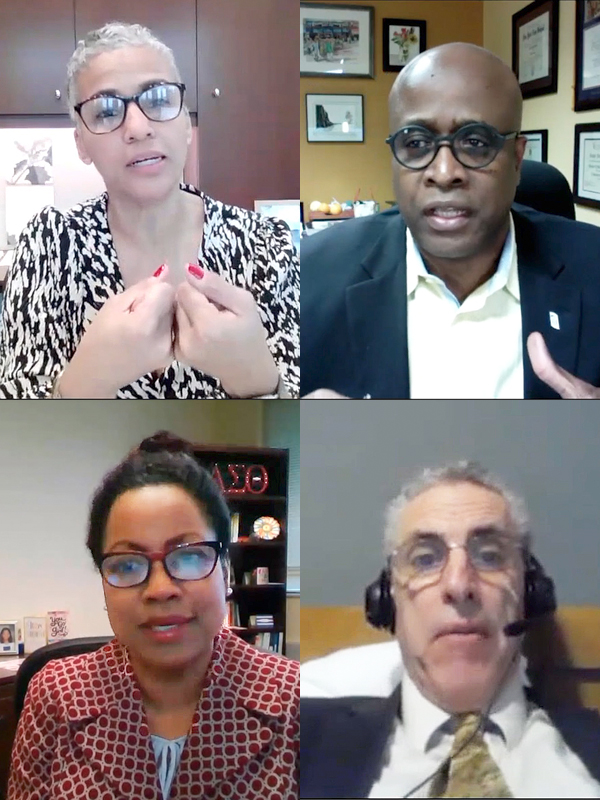President John F. Kennedy first used the term “affirmative action” the way we think of it today in an executive order in 1961, but it was his successor, Lyndon Johnson, who gave the first full-throated explanation of the reasoning behind it in his commencement speech at Howard University the year after signing the Civil Rights Act of 1964.
Johnson talked about the long history of discrimination against Black Americans and the “special nature” of the poverty thrust upon them. To make up for that, he said, “Equal opportunity is essential, but not enough. We seek not just freedom but opportunity. We seek not just legal equity, but human ability, not just equality as a right and a theory, but equality as a fact and equality as a result.”

(clockwise from top left) Renée Hutchins, Roger Ward, Mark Graber, and Diane Forbes Berthoud
For decades before that speech, the doors were closed to students of color at many elite and historically white institutions. Affirmative action has narrowed the enrollment gap, but it has faced a series of legal challenges over the last 60 years.
On Oct. 31, the Supreme Court of the United States heard arguments in two cases challenging the use of racial preferences in admissions at two universities — Harvard University and the University of North Carolina.
This isn’t the first time the high court has examined the issues surrounding affirmative action and race-conscious admissions. In 1978, the court upheld using race as one of many factors to consider but drew the line at quotas in University of California v. Bakke.
Twenty-five years later, in Grutter v. Bollinger, the justices mostly upheld Bakke. But writing for the majority, Justice Sandra Day O’Connor clarified the issue, writing that the use of race as a factor was a permissible because it furthered “a compelling interest in obtaining the educational benefits that flow from a diverse student body.” That is to say, the court permitted race-conscious admissions as long as it served the interest of creating a more diverse student body that would benefit all students.
Other cases before the court also have also upheld the use of race-conscious admissions, but that was before a supermajority of conservative justices appeared, some of whom questioned attorneys for Harvard and the University of North Carolina very closely in October.
Justice Clarence Thomas told Harvard’s attorney, “I’ve heard the word diversity quite a few times, and I don’t have a clue what it means.” Justice Samuel Alito asked for the definition of the term “underrepresented minority.” And they repeated arguments previously appearing in dissenting opinions that held granting a student an advantage based on race — any race — is constitutionally prohibited.
Importantly, much of the conversation also centered not on if race-conscious admissions in higher education should be eliminated, but when. Several times justices referred to another part of O’Connor’s Grutter opinion — the assertion that the use of racial preferences must be limited in time. The court, she said, “expects that 25 years from now, the use of racial preferences will no longer be necessary to further the interest approved today."
Liberal justices have never accepted that or any other timeline. Justice Elena Kagan argued that admissions to elite universities “are the pipelines to leadership in our society,” adding that she feared that completely eliminating race-conscious admissions would lead to “a precipitous decline in minority admissions.”
History is on Kagan’s side. In 1996, Californians voted to approve Proposition 209, which banned considerations of race, sex, and ethnicity in public contracting and publicly funded education. Almost immediately, enrollment of students from underrepresented groups in the University of California system dropped 12 percent — and at some of the system’s schools, as much as 60 percent. Since then, eight other states have adopted similar bans or restrictions on race-conscious admissions.
So, what might the court do? And if race-conscious admissions are outlawed, what can higher education do to build and maintain diverse student bodies? That was the subject of the Dec. 15, 2022, edition of Virtual Face to Face with President Bruce Jarrell. Guest host Roger J. Ward, JD, EdD, MSL, MPA, provost, executive vice president, and dean of the University of Maryland Graduate School, gathered three University of Maryland, Baltimore (UMB) experts to help sort out the issues.
Joining Ward were Renée McDonald Hutchins, JD, dean and professor, University of Maryland Francis King Carey School of Law; Mark Graber, JD, PhD, MA, professor, Maryland Carey Law, and University System of Maryland Regents Scholar; and Diane Forbes Berthoud, PhD, MA, chief equity, diversity, and inclusion officer and vice president, UMB.
Watch the entire discussion, including questions and answers with the virtual audience, by accessing the link at the top of the page.


